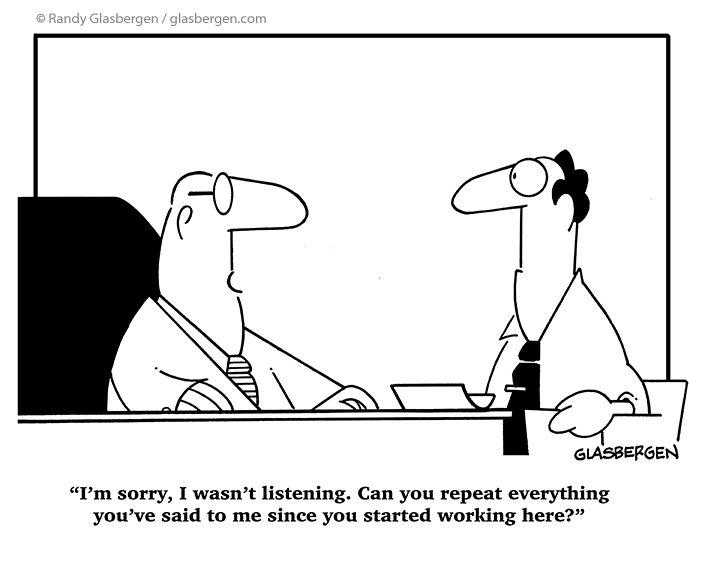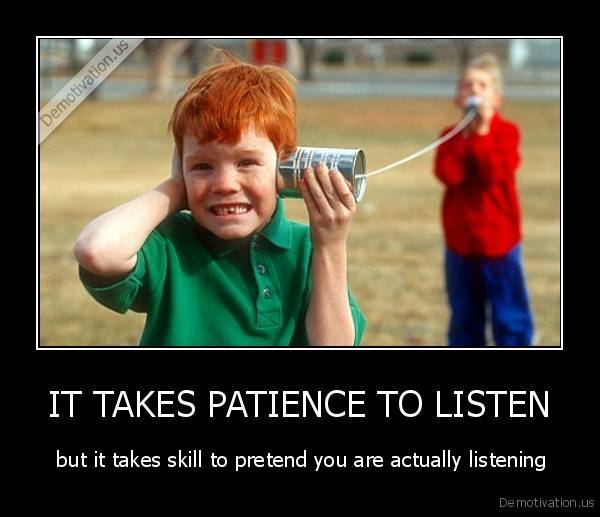Active Listening: I am not proud to admit it, but I am not always a great listener. I often fall into two traps. The first trap is that I start thinking while the other person is talking. Maybe I am thinking about something the person has said, but just as often my mind starts to wander down some different path. I get lost in my own little world, and all the while the other person is still talking. At some point, I realize I have no idea what the other person has said in the last few minutes, and I jolt back into listening.
But the other trap I fall into is a little more insidious. It is when I listen in order to prepare a counter argument. This trap occurs when I am focused on the other person, and listening to every word they are saying. So, from my perspective I am listening, but in reality, I am only listening to support my own agenda. While I might be practicing some active listening skills, I do not have the right mindset to truly understand the other person’s perspective.
What does research say about Active Listening
Unfortunately for you, I am not alone when it comes to these pitfalls in listening. These are very common mistakes that people make every day. In fact, research shows that people only remember about 17-25% of what they listened to. Let that sink in for a second. The majority of what is said, a whopping 75%, might go in one ear and out the other in your next important meeting!
So, what can we do about it? The best approach I have seen so far is used by my current company, Unity Technologies. Active Listening is a foundational skill of our culture. Every employee takes part in a program which includes: “Active Listening,” “Driving for Alignment in Meetings,” “Delivering Fierce Feedback,” and “How to Build Relationships.”
It is our hope, that by ensuring every employee (from our C-Levels to our frontline) has these skills, we can maintain our culture where everyone feels like owners, where we put our customers first, and where bold ideas become a reality. But before we dive into the practical skills of active listening, we need to ensure we have the right mindset.
The Active Listening Mindset

Having the right mindset is critical. In fact, I often think having the right mindset is even more important than having the right skills. Consider this: Would you rather have a colleague who truly believes in active listening, but just doesn’t have the right skills? Or would you rather have one that knows the right way to actively listen, but just doesn’t believe it is important?
Personally, I’d rather have the person who believes in the importance of actively listening to other people, but just doesn’t know how. This type of person will try and figure out how to learn this skill, and even if they aren’t doing the right things, they are still trying to do things in the right way.
When it comes to Active Listening, we believe there are two main mindsets that you need to hold:
Your perspective is just one of many
Too often people go into meetings or interactions thinking their perspectives and opinions are “the truth.” With this mindset, you are more likely to selectively listen. You will clearly hear ideas and opinions that support your perspective, while ignoring those that contradict it. Or, you will listen to find the holes in other people’s arguments to ensure that your perspective is seen as the right one.
Instead, go into a meeting or interaction with the knowledge you have your perspective to share and a responsibility to listen and truly understand the perspectives of the other people. I’m not saying you need to agree with their perspectives. What I am saying is that you need to focus on understanding their viewpoints, the facts they present, and their underlying beliefs.
You need to have an interest in and care about other people’s perspectives
Understanding other people isn’t for the purpose of winning the argument. You need to be truly curious about their perspective. Unfortunately, an interest in and a curiosity about other people’s perspectives is something I find lacking in a lot of businesses. When someone disagrees with us, our gut reaction is to get a little defensive. “They’re wrong. They don’t have the information I do. They haven’t considered…”
But when we become defensive, we stop listening. What we need to do is to become more curious. So, the next time someone disagrees with you, ask these questions: What are their underlying beliefs that lead them to this perspective? Is there some additional information that they have that I do not? Are they seeing something that I am not?
By recognizing that your perspective is just one of many, and by being curious and interested in learning about their perspectives, you will be primed and ready to actively listen to them.
Active Listening Skills: Engage, Clarify, and Confirm Your Understanding

Active Listening is a classic skill that is simple to understand, but difficult to master. The 3 actions of Engage, Clarify, and Confirm your Understanding might seem like common sense to you, and in truth, they are common sense actions. But as you are learning more about them, truly ask yourself if you consistently apply them in your meetings and when conversing with your colleagues.
Engage
Active Listening starts by making sure the other person is engaged in the conversation. In a one-on-one conversation, this can be easily accomplished by asking the other person open-ended questions. Ask questions that allow them to share their perspectives, and probe into what they are thinking.
In a group setting, engaging others is accomplished by making sure everyone has an opportunity to be heard. Too often meetings end up with 3 people adamantly discussing something, while the rest of the people sit quietly (some listening but others just bored). It is your job to engage these silent people in the conversation by asking them questions. What is their perspective on the topic being discussed? Have they had similar experiences with the topic? What risks or benefits do they see?
Here are some examples of questions that are meant to engage people and open up conversations to bring more perspectives to the table:
- What is your viewpoint on this?
- Hey Bob, we haven’t heard from you yet. What do you think?
- Hey Maria, what do you think our customers would say about this?
Clarify
Understanding another person’s perspective isn’t accomplished by just asking engaging questions. Often people will say something that needs to be explored or clarified further. What did you mean by that? Would you explain this further? Can you tell me more about X? These kinds of questions ensure you are clear about what they are communicating, and help you understand their whole perspective.
Asking clarifying questions is often an easy skill for most of us, as we do this naturally. When we struggle with this action, it is because we do it with the wrong mindset. Remember that asking clarifying questions is about building your understanding of another person’s perspective, not about building your counterargument to challenge it.
Here are some examples of “Clarify” questions that are meant to probe into other people’s previous statements, and build your understanding of their perspective:
- I have a clarifying question. What lead you to this perspective?
- Can you give me an example to illustrate what you mean?
- When you said X, did you consider Y or Z?
Confirm Your Understanding
The final “Active Listening” action is to confirm your understanding. Some people take this to mean providing a summary of the other person’s perspectives. While providing a summary is a part of confirmation, it isn’t the whole thing. You also need to ask if you have understood their perspective. By asking for their confirmation, you are letting them know that they have been heard, and you are also giving them a chance to correct any misunderstandings.
Too often, after listening to someone and confirming my understanding of their perspective, they tell me I misunderstood. But instead of being disappointed that I didn’t understand them, they are often happy for the chance to clarify what they meant. Ultimately, “Confirm Your Understanding” is the action that allows you mark that you have truly listened to the other person, and are now ready to move onto a different topic, tangent, or another person’s perspective.
Here are some examples of “Confirm Your Understanding” statements that not only ensure you have understood their meaning, but also lets them know they’ve been heard:
- I’d like to confirm my understanding. What I heard you say is…. Is that right?
- If I understand you correctly…
- So, what’s important to you is … Have I got that right?
Active Listening means you need to slow down

Active Listening is hard. It is so easy to be distracted by our own thoughts. You might listen to the first part of the conversation, but then immediately start planning what you are going to say in response. If we truly want to understand other people’s perspectives, we need to give them our full attention, and that means we need to slow down the conversation, and be comfortable with a little silence.
Sadly, most people dread silence and will do whatever they can to avoid it and keep the conversation flowing. But as you now know, the more you think about what you are going to say, the less time you are actually listening to the other person. So, my last piece of advice is to give your full attention and truly listen to the other person, then wait for 4 seconds after they are finished speaking. This little pause allows you to think about your reply or any more questions you want to ask.
Now, this will be tough for most of you. Although 4 seconds sounds like a miniscule amount of time, 4 seconds of silence might feel like an awkward lifetime. You will be tempted to fill the silence without really thinking about what you want to say, but don’t. Slow it down so you can actively listen to the other person and be smart in your responses.
Only by truly listening to other people’s perspectives can we achieve a culture where everyone is engaged and understood.

Leave a Reply